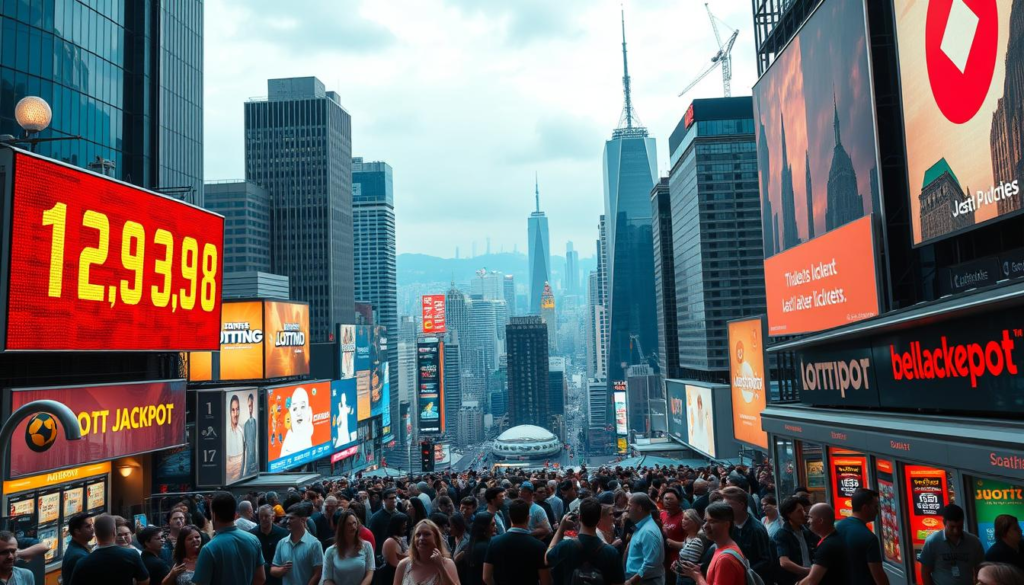We at DEWAKOIN are excited to share the remarkable story of how lotteries have positively impacted education, arts, and public services. We focus on lottery funding and its significant contributions to public education and arts support.
The California Lottery has been a beacon of support for public education. It has generated billions of dollars. This money has enhanced student education by providing support for programs and services students might not have access to. It shows the potential of lottery funding to make a positive impact on communities.
With the California Lottery raising a total of $39 billion for public education since 1984, it’s clear that lottery funding is vital. It supports public education and arts support, providing opportunities for growth and development.
Key Takeaways
- The California Lottery has provided more than $39 billion in supplemental funding for public education programs since its inception in 1984.
- Lottery funding has contributed to the growth of public education, with total K-12 payments rising from $555,457,022 in 1985-86 to $1,650,976,292 in 2021-22.
- The per ADA rate has increased significantly over the years, from $125.67 in 1985-86 to $291.35 in 2021-22, due to the exclusion of Adult Education and Regional Occupational Centers and Programs from ADA calculations.
- Eighty cents of every $2 ticket purchased for Powerball or Mega Millions is allocated to fund education programs, supporting public education and arts support.
- The California Lottery’s mission is to provide reliable supplemental funding for public education. This highlights the importance of lottery funding in supporting public education and arts support.
The Evolution of Lottery-Based Public Funding
Lotteries have changed a lot, from just being fun to a key way to fund public projects. The lottery history shows how society’s needs and the economy have changed. A big step was when the California Lottery started in 1985, aiming to help public education.
The California Lottery has grown, with changes in how it gives out money. Laws have been passed to make sure more money goes to schools. This has helped many community programs, showing the power of lottery funding.
The way lottery money is shared has changed a lot. For example, a law from 2000 made sure half of lottery growth goes to schools. This has led to more money for schools and colleges, helping education a lot.
Lotteries have shown they can adapt to society’s needs. As we deal with how lottery money is used, it’s key to see its role in education and community help. Knowing the lottery history helps us understand its role in our society and the need for safe gaming.
Understanding How the Lottery Has Contributed to Education, Arts & Public Services
We believe gaming can drive positive change. The California Lottery shows how lottery contributions can impact education funding. In the 2023-2024 fiscal year, it generated over $2 billion for public education.
This money supports many educational projects. It goes towards improving school infrastructure and funding scholarships.
Here are some examples of lottery funds in action:
- About 1.5% of the state’s education budget comes from the California Lottery.
- In 2021, the lottery gave nearly $1.9 billion to education. This is about $200 per student in K-12 schools.
- Since 1984, Los Angeles Unified School District has gotten around $3.2 billion from lottery funds.
These lottery contributions help not just education funding but also community development. They make a real difference in students’ and communities’ lives. We aim to offer a safe, fun, and rewarding online gaming experience. At the same time, we want to help society improve.
Educational Enhancement Through Lottery Funding
We see how lottery funding helps education a lot. It boosts educational funding, school infrastructure, and technology integration. This way, we can make learning better and fairer for all students.
In North Carolina, the lottery has given over $1 billion to schools in the last year. More than half of this money went to building new schools and fixing old ones. In Georgia, the lottery has given over $28 billion to schools since it started.
Here are some big wins for education from lottery funding:
- Seven school districts in North Carolina will share over $360 million in state lottery-funded grants for school construction and capital improvements.
- The Georgia Lottery Corporation has contributed over $28 billion to educational funding in Georgia since its inception.
- More than 2.1 million students have attended higher education institutions in Georgia via the HOPE Scholarship program.
Investing in school infrastructure and technology integration helps students succeed. Lottery funding is key in supporting education. It helps build a better future for all.
Artistic Renaissance: Cultural Programs and Creative Initiatives
We see how arts funding boosts cultural programs and creative initiatives. These efforts make our communities richer and more diverse. They also help the creative industries grow.
The creative industries have grown by 5% each year, beating the overall economy’s growth. This success comes from arts funding and new cultural programs. For example, Arts Council England gave £1.1 billion to the arts from 2006 to 2008. This shows the government’s support for creative initiatives.
Arts funding and cultural programs bring many benefits. They create jobs, boost local economies, and foster cultural exchange. By backing creative initiatives, we help our communities and the creative industries thrive.
- The NEA’s funding of productions such as The Great White Hope in 1967
- The Arts Council England’s distribution of over £577 million to support the arts
- The French government’s allocation of approximately $4 billion to the arts budget in 2018
These examples show the power of arts funding and cultural programs. They drive creative initiatives and boost community development. It’s crucial to keep supporting these efforts for the creative industries’ growth and success.
| Country | Arts Budget | Year |
|---|---|---|
| France | $4 billion | 2018 |
| Germany | $2 billion | 2018 |
| UK | £577 million | 2023 |
Public Service Enhancement and Community Development
We understand how important public services are for community growth. By supporting these services, we help communities and the environment thrive. Our goal is to offer a safe and fun experience while giving back through various projects.
Here are some ways we help public services:
- Infrastructure development is key for community growth and success.
- We support healthcare programs to ensure everyone gets quality care.
- Our environmental efforts help keep our planet beautiful.
We aim to positively impact people’s lives and communities. We believe everyone should have access to good public services. We’re committed to helping make this happen.
We’re always growing and improving, staying true to our mission. We’re proud of our achievements and excited for the future. We’re ready to make an even bigger difference.
Our dedication to public services and community development is strong. We’ll keep supporting initiatives that help the community and environment. Together, we can build a better future for all.
| Initiative | Objective | Impact |
|---|---|---|
| Infrastructure Development | Improve community infrastructure | Enhanced quality of life |
| Healthcare Program Support | Provide access to quality healthcare | Improved health outcomes |
| Environmental Conservation Efforts | Promote environmental sustainability | Preservation of natural resources |
Success Stories: States Leading in Lottery-Based Funding
Many states have used lottery funds to help public education, arts, and community projects. Georgia’s HOPE scholarship program is a great example. It has helped over 2 million students and given $12.6 billion to education since 1993.
California has also done well with lottery funds. In the 2023-2024 fiscal year, the California Lottery gave over $2 billion to schools. This money goes to many educational programs, including arts and scholarships. Georgia’s HOPE scholarship is another success story. It helps students who keep a 3.0 GPA in college after high school.
- Georgia’s HOPE scholarship program has contributed $12.6 billion to higher education, pre-K, and early childcare since 1993.
- California’s educational initiatives have generated over $2 billion for public education in the 2023-2024 fiscal year.
- New York’s arts support system has provided significant funding for cultural programs and creative initiatives.
These lottery success stories show how lottery funds can help education, arts, and communities. By looking at these examples, we can learn how to use lottery funds well for our communities.
Economic Impact and Revenue Generation
Lotteries have a big impact on the economy, bringing in billions of dollars each year. They help state budgets, create jobs, and boost local economies. For example, the California Lottery has made over $9 billion in sales and given more than $2.287 billion to schools.
Lotteries offer many economic benefits. They create jobs in the gaming industry and help local businesses. They also add to state budgets. In fact, for every lottery job, two more jobs are made in related fields. About 30% of lottery money goes to schools, helping education programs.
Here are some key facts about the economic impact of lotteries:
- Over $81 billion was generated by U.S. lotteries in 2021.
- Approximately $1 billion is designated for public education annually in California.
- The Florida Lottery contributed around $1.5 billion toward education in recent years.
As we look into the economic impact of lotteries, it’s key to think about the ups and downs in revenue. It’s also important to focus on responsible gaming. By understanding both sides, we can work towards a better and fairer gaming industry.
| State | Lottery Revenue | Contribution to Education |
|---|---|---|
| California | $9 billion | $2.287 billion |
| Florida | $1.5 billion | $1.5 billion |
Challenges and Criticisms of Lottery-Based Funding
Lottery-based funding faces many challenges and criticisms. Looking into lottery challenges, funding criticisms, and sustainability concerns shows us several issues. One big problem is the high overhead costs of running a lottery. These costs can take up a lot of the money made.
Some major issues with lottery funding are:
- High overhead costs, with an average of 66 cents of every lottery dollar going towards administrative expenses
- Interstate competition, which can lead to a decrease in revenue over time
- Inequitable distribution of funds, with some areas receiving more funding than others
Even with these problems, we think lottery funding can still help public services and projects. By tackling sustainability concerns and funding criticisms, we can make the system better.
| State | Lottery Funding Allocation | Overhead Costs |
|---|---|---|
| California | $1.3 billion | 21.7% |
| Georgia | $463 million | 24% decrease in student qualifications |
| Tennessee | $301 million | 8 hours of community service required |
By looking at the data and tackling these challenges, we can make lottery funding more sustainable and fair. As we go forward, it’s crucial to think about how lottery challenges, funding criticisms, and sustainability concerns affect the system’s success.
Future Prospects and Innovation in Lottery Funding
We’re excited about the future of lottery funding. It will likely see digital transformation, opening up new ways to make money and engage with communities. The mix of lottery innovation and emerging funding models will boost the impact of lotteries on public services and community growth.
Some key trends will shape lottery funding’s future:
- Digital platforms and online gaming
- Mobile payment systems and digital wallets
- Data analytics and AI-powered marketing
By adopting digital transformation and emerging funding models, we can make lottery funding more sustainable and fair for all. As we move forward, we aim to offer a safe, fun, and rewarding online gaming experience. We also want to help our communities thrive.
Conclusion: The Lasting Impact of Lottery Contributions on Society
Looking back, we see how lottery funding has changed education, arts, and public services. It shows the gaming industry’s power to make a difference. Billions of dollars have helped many people, showing the lasting good of lotteries.
Lotteries have helped improve schools, fund scholarships, and support arts and the environment. Their funding has made life better for many. This shows how the gaming industry can help society grow and improve.
Looking to the future, we see lotteries evolving with new technology. They will find new ways to help communities. By using the latest tech, they can keep making a big difference.
In short, lottery contributions have made a big difference in society. We’ve learned how the gaming industry can help communities. It’s a powerful way to make the future brighter for everyone.
FAQ
How have lotteries positively impacted education, arts, and public services?
Lotteries have raised billions of dollars. This money helps students get access to programs they might not have without it. It also supports arts and cultural programs, making our culture rich and vibrant.
Lotteries help communities by improving infrastructure, supporting healthcare, and protecting the environment. This shows how they positively impact society.
What is the evolution of lottery-based public funding?
Lotteries have changed a lot. They started as just entertainment but now help fund public services. The California Lottery is a good example of this.
Legislative changes have made sure more money goes to education and community programs. This has made a big difference.
How have lotteries contributed to education, specially?
Lottery money helps with many educational projects. It improves school buildings, funds scholarships, and buys technology for classrooms. It also helps train teachers.
These efforts have helped students and schools a lot. They help close the gap in education and improve school quality.
What is the role of lotteries in supporting arts and cultural programs?
Lottery money helps local artists and funds cultural events. It also promotes diversity in culture. This makes our communities more vibrant and diverse.
How have lotteries enhanced public services and community development?
Lottery money goes to improve infrastructure, support healthcare, and protect the environment. These efforts make communities better and healthier.
Programs like Georgia’s HOPE Scholarship show how lottery money can make a big difference. It can lead to positive changes in society.
What are the economic benefits of lotteries?
Lotteries bring in a lot of money. They create jobs and help state budgets. They are important for the economy.
What are the challenges and criticisms surrounding lottery-based funding?
There are concerns about how long lottery money will last. There are also issues with how the money is shared. Some people think there are better ways to fund things.
It’s important to work on these problems. This will help lottery funding keep improving and helping society.
What is the future of lottery funding and innovation in the industry?
The future of lottery funding looks bright. It will involve using technology and new ways of funding. It will also learn from other countries.
This will help lotteries keep making a positive impact. They will continue to be important for society’s well-being.


